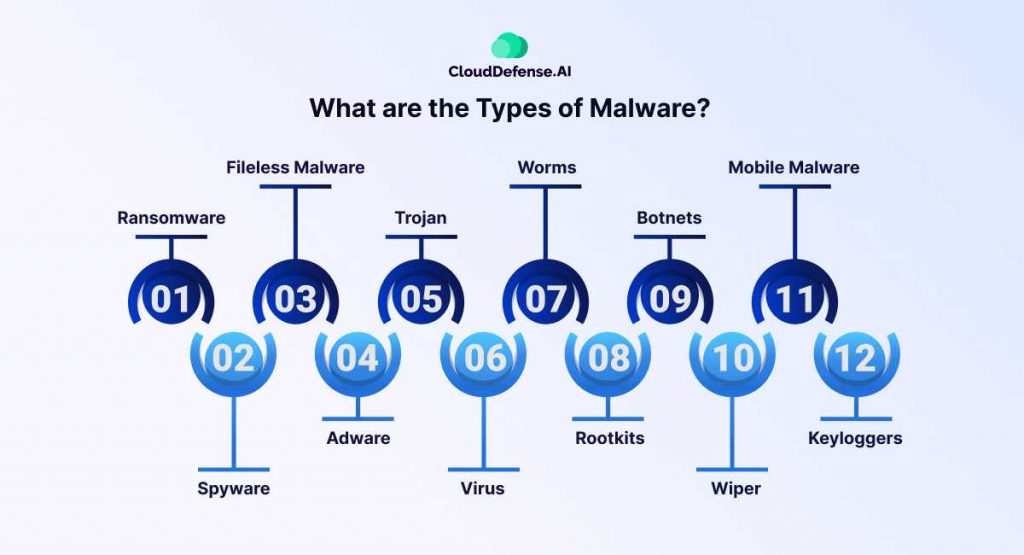Malware poses great risks to computer systems worldwide. In 2022 alone, a staggering 5.5 billion malware attacks were recorded, which highlights the prominence of Malware in cybersecurity.
Understanding Malware and the many types they come in can take you a long way to protect against potential threats to your infrastructure. Whether it’s falling victim to deceptive links or experiencing file hijacking, the impact of malware can be seriously grave.
A quick read of this guide will help you to discover 12 major types of malware, together with their examples. Keep reading to empower yourself with this much-needed cybersecurity insight.
What is Malware?
Malware, a condensed term for “malicious software,” encompasses a broad spectrum of harmful programs designed by cyber criminals to compromise computers and networks. It’s essentially software crafted with malicious intent to disrupt operations, steal sensitive data, or render systems inoperable.
This harmful software includes various types such as viruses, worms, Trojan horses, ransomware, spyware, and adware. Unlike legitimate software aimed at enhancing user experience, malware operates with the sole objective of causing harm. Its effects range from data theft and system damage to extortion through ransom demands.
Malware poses a significant threat to individuals, businesses, and organizations, as recent incidents have demonstrated its ability to exfiltrate massive amounts of sensitive data, disrupt operations, and compromise cybersecurity defenses.
What are the Types of Malware?

There are loads of different Malware available out there. However, we will only discuss these 12 major Malware that you are more likely to encounter.
1. Ransomware
Ransomware is a type of malicious software that encrypts data on a victim’s computer or network, rendering it inaccessible until a ransom is paid to the attacker. This form of cyberattack can cause significant financial and operational damage to individuals and organizations alike. Victims often find themselves in a precarious situation, where they must weigh the potential costs of paying the ransom against the uncertainty of whether they will receive a valid decryption key in return.
Ransomware Example
An example of ransomware is the RobbinHood attack that targeted the city of Baltimore, disrupting various municipal activities including tax collection and property transfers. Another notable incident involved the city of Atlanta, which fell victim to a similar ransomware attack named RobbinHood in 2018, incurring substantial financial losses amounting to $17 million.
2. Spyware
Spyware is a form of malicious software designed to clandestinely collect sensitive information about users’ activities without their knowledge or consent. This covert data collection may include passwords, banking credentials, personally identifiable information (PII), and internet browsing history. Spyware can infiltrate systems through various means, including phishing attacks, social engineering tactics, and malicious downloads. One common type of spyware is keyloggers, which record user keystrokes to capture password data and other confidential information.
Spyware Example
An example of spyware is the Android/SpyC23.A variant, utilized by the ATP-C-23 advanced persistent threat group. This sophisticated spyware, discovered by Sophos in November 2021, targets Android devices through compromised apps. Once installed, Android/SpyC23.A gains admin permissions, enabling attackers to access sensitive files, lock the device, install or uninstall apps, and disable security notifications. This variant can also connect to alternate command-and-control servers if the primary server is taken down, and it conceals notifications from security apps and the Android system to evade detection.
3. Fileless Malware
Fileless malware is a sophisticated form of malicious software that operates without installing any files on the target system. Instead, it manipulates existing files native to the operating system, such as PowerShell or Windows Management Instrumentation (WMI), to execute its code. Because these changes are made to legitimate files recognized by the operating system, fileless attacks often go undetected by traditional antivirus software, making them highly stealthy and successful. Emerging as a mainstream cyber threat in 2017, fileless malware presents a significant challenge to conventional security measures due to its ability to evade detection and persist even after system reboots.
Fileless Malware Example
Frodo, discovered in October 1989. Although not a true fileless virus, Frodo is considered a precursor to fileless malware because it is loaded into the boot sector of a computer. Despite being relatively harmless and displaying the message “Frodo Lives” on infected screens as a prank, Frodo demonstrated the potential for malware to execute without the need for traditional file installation, laying the groundwork for future fileless attacks.
4. Adware
Adware is a type of software that tracks a user’s browsing behavior to serve them targeted advertisements. Unlike spyware, adware does not install any software on the user’s computer or capture keystrokes. However, it poses a significant threat to privacy by collecting data about the user’s online activities, including websites visited and search queries, to create a detailed profile. This information can be shared or sold to advertisers without the user’s consent, leading to potential privacy violations.
Adware Example
Fireball infected 250 million computers and devices in 2017. It hijacked browsers to change default search engines and track web activity. While initially functioning as a nuisance by bombarding users with unwanted ads, Fireball had the potential to escalate into a more serious threat, as three-quarters of the malware was capable of running code remotely and downloading malicious files.
5. Trojan
A Trojan, short for Trojan horse, is a type of malicious software that disguises itself as legitimate code or software. Once unsuspecting users download and execute the Trojan, it can take control of their systems for malicious purposes. Trojans often hide in seemingly harmless programs, games, or attachments included in phishing emails. They can be used to capture sensitive data, gain unauthorized access to networks, delete or modify files, harvest devices for use in botnets, or spy on user activity.
Trojan Example
Zeus, also known as Zbot, is a notorious banking Trojan discovered in 2007. Zeus operates by utilizing keylogging techniques to steal login credentials and other sensitive data from victims. This Trojan has caused significant monetary losses for individuals and organizations since its identification, highlighting the serious threat posed by Trojans in the cybersecurity landscape.
6. Virus
A virus is a type of malicious software that inserts itself into an application or program and executes when the application is run. Once activated, a virus can perform various harmful actions, such as stealing sensitive data, launching DDoS attacks, or initiating ransomware attacks. Viruses have the capability to replicate and spread from one system to another, often through infected files or networks.
Virus Example
One of the most notable examples of a computer virus is the Morris Worm, which emerged in 1988. Developed by Robert Tappan Morris, the Morris Worm was a self-replicating program that spread rapidly across the early Internet, infecting thousands of computers and causing widespread disruptions. The Morris Worm exploited vulnerabilities in Unix systems, slowing down or crashing many machines it infected. This incident underscored the destructive potential of computer viruses and highlighted the importance of cybersecurity measures in protecting against such threats.
7. Worms
A worm is a type of malicious software that targets vulnerabilities in operating systems to spread itself across networks. Unlike viruses, worms do not require a host program to attach to and can replicate independently. They often exploit backdoors in software, unintentional vulnerabilities, or external devices like flash drives to gain access to systems. Once infiltrated, worms can be used by cyber attackers to launch Distributed Denial of Service (DDoS) attacks, steal sensitive data, or deploy ransomware.
Worms Example
One notable example of a worm is Stuxnet, which is believed to have been developed by US and Israeli intelligence forces to disrupt Iran’s nuclear program. Stuxnet was introduced into Iran’s network through a flash drive, targeting industrial controllers that managed uranium enrichment processes. Although initially intended to stay within the air-gapped network, Stuxnet managed to spread beyond its intended target, highlighting the aggressive and unpredictable nature of worms.
8. Rootkits
A rootkit is a type of malicious software that grants unauthorized remote control of a victim’s computer with full administrative privileges. These stealthy programs are designed to embed themselves deeply within a computer’s core, making detection challenging for conventional security measures. Rootkits can be injected into various system components such as applications, kernels, hypervisors, or firmware, often spreading through phishing, malicious attachments, downloads, or compromised shared drives.
Once installed, rootkits manipulate system functions and processes, allowing cybercriminals to conceal their presence while executing various malicious activities such as data theft, keystroke logging, remote control, and creating backdoors. They are particularly dangerous as they compromise system integrity and provide prolonged, surreptitious access without detection.
Rootkits Example
TDSS is an example of a rootkit targeting Windows systems, also known as Alureon, discovered in 2007. This rootkit manipulates the Windows registry to disable essential functions like Task Manager, update functions, and antivirus programs, enabling the creation of botnets and creating further malicious activities.
9. Botnets
Botnets are networks of compromised computers, also known as bots, that are controlled remotely by a central server. These bots are typically infected with malicious software, allowing cybercriminals to execute automated tasks or launch coordinated attacks without the users’ knowledge.
Botnets are commonly utilized to conduct large-scale attacks, such as DDoS attacks, where multiple compromised devices flood a target system or network with an overwhelming volume of traffic, causing it to become unavailable to legitimate users.
Botnets Example
Echobot is a variant of the infamous Mirai botnet. It targets a wide range of IoT devices, exploiting numerous vulnerabilities, including those found in Oracle WebLogic Server and VMWare’s SD-Wan networking software. This botnet is capable of launching DDoS attacks, disrupting supply chains, stealing sensitive information, and even conducting corporate sabotage by exploiting unpatched legacy systems.
10. Wiper
Wipers are a malicious type of malware designed specifically to erase user data irreversibly, rendering it unrecoverable. Unlike other forms of malware that may aim to steal data or disrupt operations, wipers have a singular focus on destruction, often used to take down computer networks in public or private organizations across various sectors.
Wiper Example
One wiper attack occurred on January 14, 2022, when the Ukrainian government faced a coordinated assault on 22 of its government agencies. In this attack, the perpetrators defaced the websites of the targeted agencies. The compromised websites were predominantly developed by a Ukrainian IT company called Kitsoft and were all built on the OctoberCMS platform. This incident suggests a potential supply chain attack on the IT provider or exploitation of vulnerabilities within the OctoberCMS platform, possibly in conjunction with exploits targeting the Log4Shell vulnerability (T1190).
11. Mobile Malware
Mobile malware refers to malicious software specifically designed to target mobile devices such as smartphones and tablets. These threats encompass a wide range of malicious activities, including but not limited to Trojans, ransomware, adware, and click fraud schemes. Mobile malware is distributed through various means, including phishing attacks, malicious downloads, and compromised app stores.
Mobile Malware Example
Triada, a rooting Trojan that infiltrated the supply chain by being pre-installed on millions of Android devices. Triada gains root access to sensitive areas of the operating system, allowing it to install spam apps. These spam apps display unauthorized ads, often replacing legitimate advertisements. Revenue generated from clicks on these ads is directed to the developers behind Triada, illustrating the financial motivation behind such malware attacks on mobile devices.
12. Keyloggers
A keylogger is a type of spyware designed to monitor and record user keystrokes on a computer or mobile device. While keyloggers can have legitimate uses, such as monitoring employee activity or supervising children’s online behavior, they can also be deployed for malicious purposes. Malicious keyloggers are capable of capturing sensitive information like passwords, banking details, and other confidential data without the user’s knowledge or consent. They are typically inserted into a system through phishing attacks, social engineering tactics, or malicious downloads.
Keylogger Example
Olympic Vision has been utilized in targeted attacks against businessmen in the US, Middle East, and Asia for business email compromise schemes. It uses spear-phishing and social engineering methods to infect victims’ systems, allowing cybercriminals to steal sensitive data and monitor business transactions. Despite its relatively simple design, Olympic Vision is widely accessible on the black market for as little as $25, making it a popular choice among malicious actors.
Malware Detection and Removal with CloudDefense.AI
CloudDefense.AI offers a robust suite of solutions designed to detect and remove malware effectively. Through their innovative Hacker’s View™ solution, they provide valuable insights by continuously monitoring for vulnerabilities and potential intrusion pathways, empowering organizations to anticipate and mitigate attacks proactively.
CloudDefense.AI’s Noise Reduction technology further enhances threat detection by prioritizing critical risks, allowing users to focus on actionable insights and reduce actual threats efficiently. With seamless integration into the development process, their “Code to Cloud” approach ensures that security best practices are embedded from the earliest stages, preventing malware vulnerabilities from proliferating into production environments.
From infrastructure scanning to real-time threat detection and automatic remediation, CloudDefense.AI delivers comprehensive protection against malware across cloud environments. With their user-friendly dashboard, both technical and non-technical users can easily detect and remove malware, enabling informed decision-making and swift response to security incidents. Book a free demo with us now and experience all of this greatness!12 Types of Malware + Examples That You Should Know







